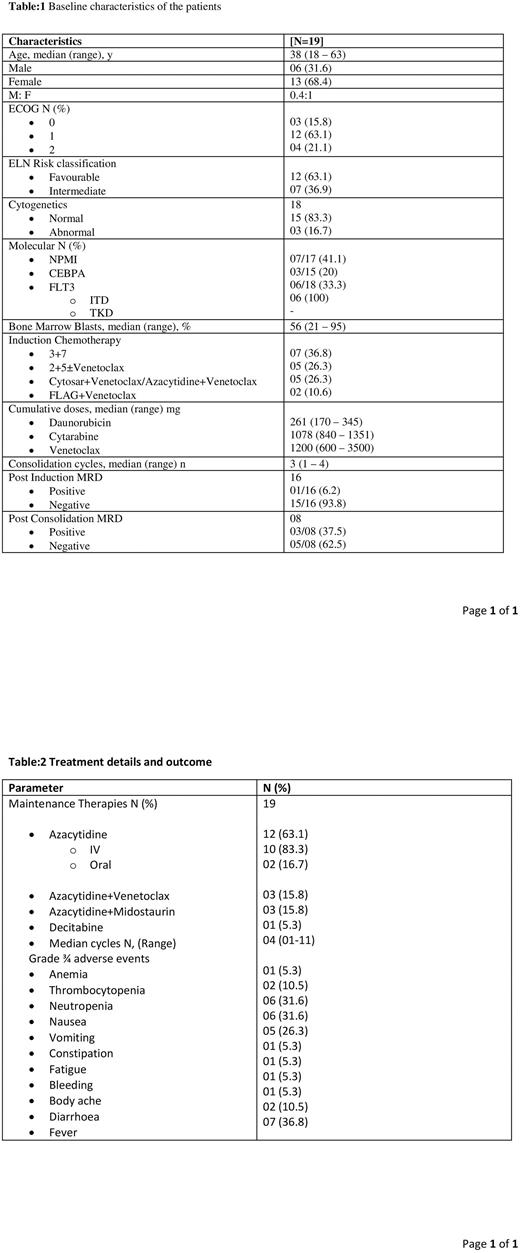Abstract
Background: Acute myeloid leukemia (AML) is a heterogenous disease with variable outcomes among different risk groups. Favourable risk group AML after consolidation chemotherapy have long-term- leukemia-free survival of 60-70% [1]. Also, many patients in India in the intermediate risk group do not opt for allogenic hematopoietic stem cell transplant due to financial constraints, non-availability of fully matched donors and due to reservations regarding non relapse mortality associated with transplant. Previous studies have shown the value of azacytidine maintenance in prolonging overall survival and relapse free survival in older patients of AML [2]. We conducted this study to assess the results of hypomethylating agents as maintenance in non-adverse risk, younger AML patients who did not receive allogeneic stem cell transplant.
Methods:
Adults with de-novo AML (>18 years) who received treatment at our centre from January 2021 to December 2021 were included in our retrospective analysis. Induction therapies used were out of these 4 as per physician's choice- 3days x daunorubicin+7 x cytarabine; 2days x daunorubicine + 5 x cytarabine +venetoclax; azacytidine+venetoclax; Fludarabine+Cytarabine+venetoclax.
Complete remission was defined as per the ELN 2017 criteria [3]. Measureable residual disease assessment was done by multiparametric flowcytometry or by PCR for patients who had NPM1 mutation or inversion 16.
Consolidation chemotherapy comprised of received 3-4 cycles of intermediate dose cytarabine at a dose of 1500mg/m2 twice daily on days 1, 3 and 5. Midostaurin was administered at a dose of 50mg twice daily on day 8 through 21 in FLT3 mutated patients.
Patients who were in remission after consolidation therapy received maintenance using hypomethylating agents such as Azacytidine or decitabine alone or in combination (Venetoclax 100mg x 4 days with Voriconazole 200mg twice daily). Midostaurin 50mg twice daily or Sorafenib 200mg twice daily was given if FLT3-ITD/TKD mutated in addition to the hypomethylating agents. Our aim was to asses the tolerability and results of maintenance azacytidine in a non-selected cohort.
Results
Fifty-three AML patients received induction therapy during the study period and out of which 23 patients went on to receive consolidation with cytarabine. Seven patients were consolidated with allogeneic bone marrow transplant, 7 had refractory AML and 3 were induction deaths, (1) relapsed post consolidation, (1) did not receive maintenance. These were excluded from the analysis. Seventeen patients were lost to follow up after induction.
Nineteen patients were started on hypomethylating agent maintenance. Baseline characteristics of the cohort are shown in Table 1. The median consolidation chemotherapy cycles were 3 (range 1-4).
The cumulative doses of Daunorubicin used was 261mg (range-170 to345), cytarabine 1078mg (range 840 to 1351) and venetoclax 1200mg (range 600 to 3500mg).
Post induction measurable residual disease MRD was positive in 01 out of 16 patients and post consolidation MRD was positive for 03 out of 08 patients. These 3 patients who were MRD positive post consolidation received azacytidine and venetoclax as maintenance.
Table 2 showing the distribution of maintenance and the grade ¾ adverse events in patients who were on maintenance. Two patients in the maintenance cohort relapsed belonging to the MRD negative group.
Both these patients received salvaged chemotherapies and are awaiting allogenic transplant.
Conclusion
Azacytidine maintenance is feasible option for preventing relapses in patients with favourable and intermediate risk AML who do not choose bone marrow transplant as consolidative therapy, however further studies are warranted.
Disclosures
No relevant conflicts of interest to declare.
Author notes
Asterisk with author names denotes non-ASH members.


This feature is available to Subscribers Only
Sign In or Create an Account Close Modal